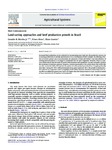Please use this identifier to cite or link to this item:
http://www.alice.cnptia.embrapa.br/alice/handle/doc/956188| Title: | Land-saving approaches and beef production growth in Brazil. |
| Authors: | MARTHA JUNIOR, G. B.  ALVES, E. R. de A.   CONTINI, E.   |
| Affiliation: | ELISEU ROBERTO DE ANDRADE ALVES, DE-PR. |
| Date Issued: | 2012 |
| Citation: | Agricultural Systems, v. 110, p. 173-177, July, 2012. |
| Description: | Increased food production can be achieved by incorporating more land into the productive process, by increasing productivity in already opened areas or by a combination of both strategies. By allowing a fraction of current pasture area to accommodate the expansion of food and biofuel crops intensification of existing pastoral systems is a strategy to avoid further loss of native vegetation. However, there is a common misperception that the path of growth of the Brazilian beef production has been primarily based on the expansion of extensive pastures. Empirical evidence presented in this article shows that whilst this was the case for the 1950?1975 period, the pattern of cattle production in Brazil has changed profoundly since then. During the 1950?2006 period productivity gains explained 79% of the growth in beef production in Brazil and supported a land-saving effect of 525 million hectares. Therefore, without this land-saving effect an additional pasture area that is 25% higher than the Amazon biome in Brazil would be needed to meet current levels of Brazilian beef production. |
| Keywords: | Increased food production Perda de vegetação nativa |
| Notes: | Na publicação: Eliseu Alves. |
| Type of Material: | Artigo de periódico |
| Access: | openAccess |
| Appears in Collections: | Artigo em periódico indexado / Embrapa Unidades Centrais (AI-SEDE)  |
Files in This Item:
| File | Description | Size | Format | |
|---|---|---|---|---|
| Landsavingapproches.pdf | 332.6 kB | Adobe PDF |  View/Open |









